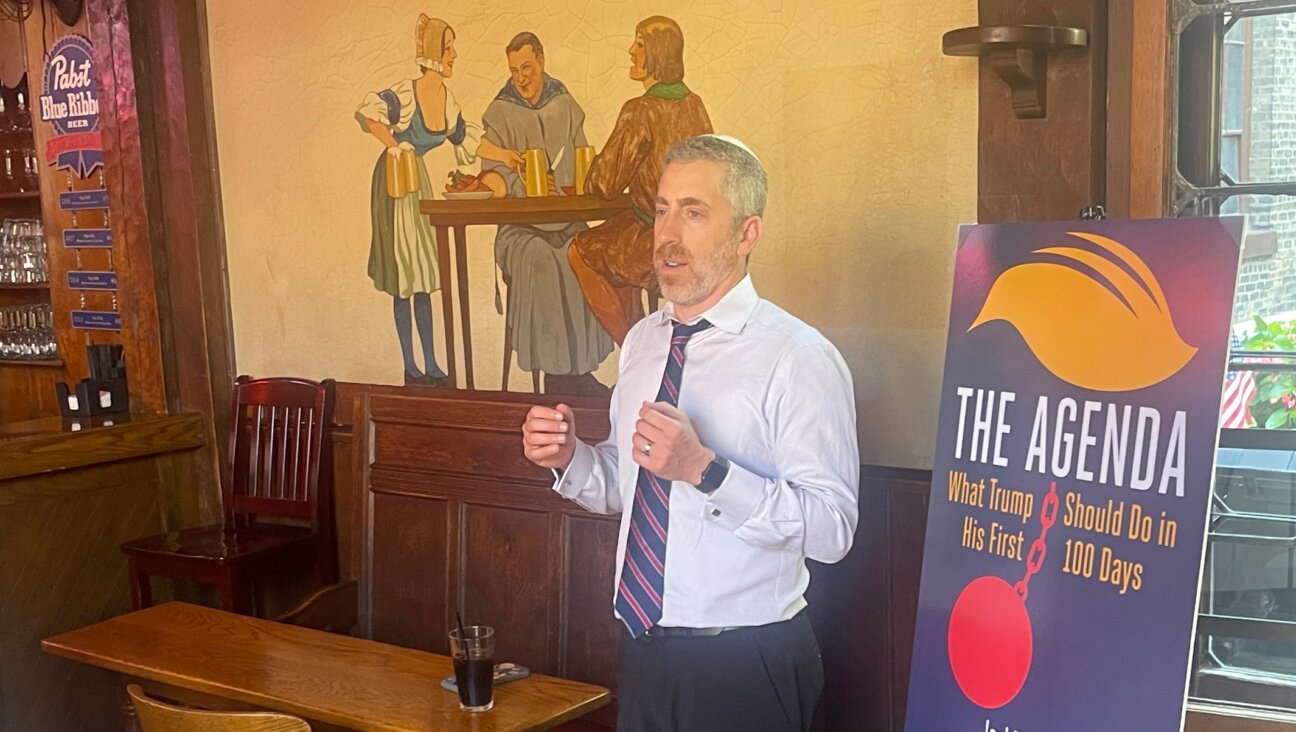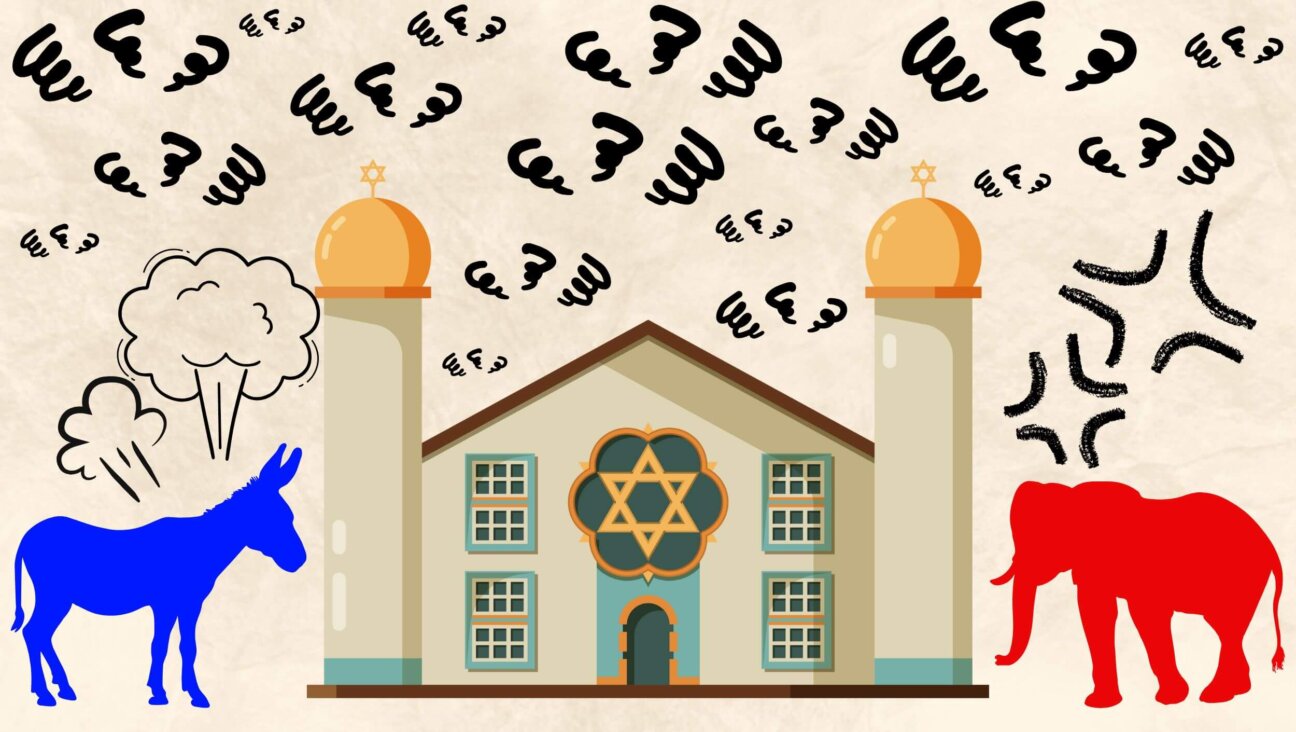How the Hasids Won the Battle of Bloomingburg — and Everyone Else Lost

Image by Josh Nathan-Kazis
When Mrs. F. and her husband decided to move away from Kiryas Joel, the upstate New York shtetl where they grew up, they went to their rebbe to ask for advice.
The couple couldn’t move just anywhere. Both are members of the Satmar Hasidic group, and like all ultra-Orthodox Jews, they had special requirements: a place to pray, a place to take ritual baths, a place for their children to go to school. What’s more, as followers of the grand rabbi of Satmar, they wanted to be somewhere a rebbe would be in control.
BREAKING: Federal prosecutors have indicted three men for conspiring to corrupt Bloomingburg’s elections. For breaking details, click here.
“I was looking to go to a place where there is authority,” said Mrs. F., now 30. “There has to be someone that sets the rules.”
The couple had their eye on a place a half-hour outside Kiryas Joel, in a tiny village called Bloomingburg. It was a cozy little house on its own lot near Main Street, with a wood burning stove and a shed in the yard. Back home, Mrs. F. says, something like that would set them back over $750,000. The house in Bloomingburg was on sale for a quarter of the price.
The place sounded nice, Zalman Teitelbaum, the Satmar rebbe, told Mrs. F.’s husband. But Teitelbaum said that he could not be the rebbe of Bloomingburg. Not yet. Maybe someday soon.
It wasn’t exactly a yes, and it wasn’t exactly a no, so Mrs. F. and her husband decided to let fate decide. They put in an application with the bank that was selling the house, and they waited. When the deal went through, they bought on faith. “It was a sign from heaven that this is what we should do,” Mrs. F. said.
Two years later, it looks like heaven may have been right.
Since 2012, Bloomingburg has been a battleground, the latest front in a multi-pronged conflict playing out across New York and New Jersey, as ultra-Orthodox communities seek room to grow. Upstate in Kiryas Joel, in the suburbs around New Square and Monsey, in Lakewood and Lawrence, and even in the heart of Brooklyn, Orthodox groups have clashed with their neighbors over expansion plans and control of local government.
To the Orthodox and their allies, resistance to new Jewish neighbors can look like anti-Semitism. To the non-Orthodox, the arrival of a Hasidic community, with its schools and its institutions and its rabbinic authority, can feel like an invasion.
In Bloomingburg, local governments and an Orthodox developer have faced off in court, and in raucous village meetings, amid a volley of accusations of voter fraud and hate crimes.

A storefront on Bloomingburg’s main street in 2014, left, and late 2016. Image by Martyna Starosta / Josh Nathan-Kazis
For years it looked as though Bloomingburg could go either way. Court challenges and political fights were heated, and it seemed like a real possibility that the new Hasidic village 80 miles north of New York City might fail. Without the Satmar rebbe’s blessing, Bloomingburg was in limbo, a place where some Orthodox Jews might make a home, maybe, but not a full-fledged Hasidic village — what Yiddish-speakers like Mrs. F. would call a shtetl.
But now it seems like the battle for Bloomingburg is ending. New Hasidic families are moving in all the time. Construction on a ritual bath is ongoing. And down Main Street, just next door to the firehouse, a huge Satmar school for boys is nearly ready to open its doors.
Opponents, bereft, are trying to understand how they lost control of their village. Bloomingburg will be a Satmar settlement. The fight, it seems, is over.
Shalom Lamm Has a Plan
Bloomingburg is a bare intersection at the foot of the Catskills; a few vacant storefronts where cow country used to meet the Borscht Belt. These days, the cows are mostly gone, and the hack comedians are, too. What’s left is a diner, a closed hardware store, a Chinese restaurant and a developer named Shalom Lamm, who has bought up nearly everything in sight.
For the locals who came to Bloomingburg for the rural quietude, for the dairy farms and the diners, the arrival of Lamm was the start of a slow-motion catastrophe.
Lamm came with a plan, according to secret documents revealed in court earlier this year: to build 5,000 units of housing in the area over a decade and a half. It would mean a giant change to the character for the area. The entire town of Mamakating, which encompasses Bloomingburg, had just 12,000 residents in 2010.
Lamm’s intentions were kept quiet, and residents say they thought for years that he was building a golf course. When a dense set of single-family homes began going up on one of Lamm’s lots in 2012, there was shock in Bloomingburg, followed by fury.

Bloomingburg is a tiny village in Sullivan County, New York. The Chestnut Ridge development is just south of town, on Winterton Road. Image by Google Maps
In fact, Lamm, the son of the prominent Modern Orthodox rabbi Norman Lamm, had been in touch for years with Satmar activists, who were interested in the developer’s plans. The village was to be a bold new venture for the Satmar, a second upstate shtetl for the fast-growing, ultra-religious group. After the sect split in 2006, one of the two dueling Satmar grand rabbis, Aron Teitelbaum, settled in Kiryas Joel. His brother, Zalman Teitelbaum, took the Williamsburg section of Brooklyn. While followers of both brothers live in both places, housing pressures in Williamsburg have spurred Zalman Teitelbaum’s followers to seek a shtetl of their own.
By 2014, however, when Mrs. F. and her husband were looking to buy, the development had stalled out. Opposition in the town government and the courts had frozen construction. While some Hasidim had moved to Bloomingburg, progress had halted on the school, the ritual bath and Lamm’s big development. On the streets of Williamsburg, where the rebbe lives, there were rumors that the Bloomingburg shtetl might fail.
“There was a time when there was uncertainty how it was going to pan out,” acknowledged Samuel Stern, a Satmar activist in Zalman Teitelbaum’s camp in Williamsburg. The rebbe will “not send people to a desert if it’s not going to work out in the end,” Stern said, meaning a village without the necessary basics for a Hasidic life. “He feels responsibility for these families.”

Developer Shalom Lamm, pictured here at Chestnut Ridge in 2014, has bought up hundreds of acres around Bloomingburg. Image by Martyna Starosta
Satmar settlements have failed in the past. A little more than a decade ago, Satmar leaders encouraged their Hasidim to move to Bayswater, a remote neighborhood in Queens. When zoning changes in Williamsburg opened up new housing there, the Bayswater project was dropped and Satmar who had already moved found themselves stranded, with no school for their children and no community. It was a disaster, and the Satmar leadership didn’t want to repeat their mistake.
So when Mrs. F.’s husband asked Zalman Teitelbaum what to do about their move to Bloomingburg in 2014, the rebbe was noncommittal. “He was like, there were certain things that needed to be done to take it under his responsibility,” Mrs. F. said. “He said, ‘I’m in the middle of working it out.’”
(Mrs. F., like many Hasidim, was uncomfortable with having her name appear in the press. She agreed to be referred to by an initial.)
That was how things stood when Mrs. F. and her husband moved to town, and how things remained through their early months there. Mrs. F. says that the Hasidim she met when she moved to Bloomingburg were a hodgepodge of followers of different sects.
That didn’t last.
In late 2015, a judge dismissed a federal lawsuit that the town had brought against Lamm. And early in 2016, candidates friendly to Lamm’s development won the majority on the village board, lifting restrictions on building that their predecessors had put in place.
It’s unclear exactly which changes helped convince Teitelbaum that he could officially take Bloomingburg under his oversight. Whatever the cause, Teitelbaum signaled the move in early 2016, making a weeklong visit to the village around Passover, just after his annual return from his winter home in Florida. To the Satmar, it meant that Zalman Teitelbaum had given Bloomingburg his official blessing. Bloomingburg was no longer just some village where some Hasidic families were making a go of it. It was now a Satmar village, with the Satmar rebbe’s seal of approval. Almost immediately, things began to change.
Non-Satmar Hasidim have left town, according to Mrs. F. Construction in Lamm’s development, called Chestnut Ridge, has resumed after years of holdups. The rebbe makes regular visits to check on progress.
“Everything is improving,” Mrs. F. said. “It feels like it’s actually going to develop into something.”
Stuck
That progress that’s cheering Mrs. F. is the worst possible news for Danny and Leslie Wise.
The couple bought their converted farmhouse in Bloomingburg in 1999. It’s a beautiful old building, with wood beams and plenty of space for their two cats. They moved up from Manhattan, but Danny Wise continued to commute to his job down in the city. He loved going back and forth. At night he would come home to the smell of the cows at the farm down the road. “To see the cows and then see the skyscrapers was the most amazing thing,” he said.
That farm is now the site of Lamm’s Chestnut Ridge development.
“The dairy farm was what drew us,” he said. “Now it’s the bane of our existence.”
The Wises, who are Jewish, have been vocal opponents of Lamm’s development. Now that the battle is very nearly lost, they are in despair. The couple believes that their home is worth far less than what they paid for it nearly 20 years ago, and they blame Lamm’s development. They say they are stuck.

Leslie Wise, at home near the Chestnut Ridge development. Image by Josh Nathan-Kazis
“I feel bad that Williamsburg isn’t big enough anymore, but what about me?” Leslie Wise said. “What about every member of this community who has sunk their entire life’s worth into a house and home for their families?”
Their complaints about the changes wrought by the development are deeply felt, and wide-ranging. They say that the road into town is crowded with Hasidic people walking on the shoulder, and has become a hazard. They also say that neighbors are angry and suspicious of each other.
Most of all, though, they’re angry about how it all happened. They feel like their town has been taken over by underhanded means. They feel like the state and federal officials they turned to for help have turned their backs. They see corruption everywhere, and they are furious at the people who let it happen.
“I don’t trust anybody anymore,” Leslie Wise said. “This has just been one lie after another.”
A Yeshiva Grows in Bloomingburg
Whenever a new Hasidic family moves into Bloomingburg, Moshe Meisels shows up with soup.
“It’s gonna be vegetable soup or chicken soup, doesn’t matter,” Meisels said. A tall, skinny 25-year-old Hasid, he moved up from Brooklyn after being approved for federally subsidized housing in Sullivan County, New York, under the Section 8 program. Right now he’s unemployed, but his wife is working. His work is to make everyone feel welcome.
“My big job now is to make everybody smile over here,” he said. “I am the clown.”

A former warehouse in Bloomingburg will soon be ready to house a Satmar yeshiva for boys. Image by Josh Nathan-Kazis
It was drizzling in Bloomingburg, but a new Hasidic family was moving into one of the completed townhouses in Chestnut Ridge. Meisels says that when he first moved there in January, the development was sealed up, with a guard at the gate.
“You couldn’t come in without permission,” he said. “Nobody was living here.”
Over the past few months, he’s watched it fill. Now, most of the homes on the first block in Chestnut Ridge are sold, and a frenzy of construction has enveloped the back lots. Meisels and others estimate that there are around 50 Hasidic families in the village, with more moving in all the time. They find work in nearby Middletown, or they sell things on Amazon.com.
One man said that he sells pet accessories on Amazon and is hoping to branch into cat clothes, although he himself has no cats. “I got eight kids,” the man said. “I have no place for a pet.”
Slowly, the Hasidic families are making themselves at home in Bloomingburg. There’s a small kosher grocery store on Main Street. There’s a one-page Yiddish newsletter with local ads. A kosher pizza shop on Main Street is supposed to open in a couple of weeks.

At a heated Village Board meeting in Bloomingburg this August, a woman yells at Moshe Meisels. Image by Times Herald-Record/Jim Sabastian
The biggest change, though, is the Satmar school. Today, Hasidic children of elementary school age are bused to Kiryas Joel for their classes. Bloomingburg’s own Satmar school, long delayed, should be open in a matter of months, according to a spokesman for Lamm’s firm.
The building, once a warehouse, was full of construction workers on a recent Tuesday. Sheets of printouts marked with the school’s name, Mosdos Satmar of Bloomingburg, showed which skeletal space would become an office and which a classroom. Nearly complete, the school looks huge, a facility capable of serving far more than the 50 Hasidic families already in town.
Showdown at the Quickway Diner
The Quickway Diner is Bloomingburg’s main gathering spot, an old-fashioned diner with a gas station out front and a car dealership in the back. In the summer, it’s a popular stop off Route 17 on the way to the Catskills. In the early winter, it’s just locals.
These days, it’s a good place to get into an argument about Lamm’s development.
Holly Roche sat in the back around lunchtime, sipping a hot tea and talking about how the steamroller progression of Lamm’s designs has made Bloomingburg feel like a banana republic.
“That’s not a good feeling,” Roche said, “because it takes your sense of foundation and it blows it away.”
Roche, who is Jewish, was the founder of an anti-development group called the Rural Community Coalition, which drew hundreds of locals to its meetings at the peak of the struggle in 2014. She hasn’t given up her fight. But she’s running short on options, and now she’s angry at some of her allies.
Roche thinks that Lamm successfully used claims of anti-Semitism as a cudgel against his opponents. “I think the screaming of anti-Semitism is the developer’s tool,” Roche said. And she thinks that some on her side gave Lamm the ammunition he needed.
Tamara Block, having lunch two tables away, jumped into the conversation. Block, also Jewish, moved up from Williamsburg 10 years ago. A secular Jew, she’s lived with Hasidim before, and she says she’s afraid she’ll lose her village as the Hasidic community continues to grow.
“I know what happens,” Block said. These days, Block says, a non-Hasid can’t even drive through Kiryas Joel. “That’s an eruv on steroids,” she said. Roche pushed back. “You’re against an entire group?” she asked. “I don’t get where you go with that.”
“I’ve been on the inside,” Block said.
Block, a cabinet maker, is concerned about the local school district. She’s read about East Ramapo, the Rockland County, New York, district where the school board is dominated by residents of ultra-Orthodox communities in New Square and Monsey. East Ramapo has been locked in years of conflict, as the school’s services have declined, and a state-appointed monitor has said that the Orthodox-dominated public school board put the interests of private yeshivas over those of the public schools.
“I feel that there’s too much religion getting into the area of politics,” Block said.
But Block is sympathetic to Roche. She hears how some of her own critiques can sound like anti-Semitism, even though she feels as though she is criticizing the choices that the Hasidim make and not their religion.
“Nobody has tried harder than you,” Block told Roche, as she left the Quickway. “I feel like you’ve been knocking your head against a brick wall. I don’t know how you get up in the morning.”
Pioneers
Even as the Satmar move to claim Bloomingburg as their own, life is still a challenge for the early Orthodox residents. A shtetl isn’t built in a day, and Bloomingburg still lacks many of the basics of Hasidic life.
There is, for example, no ritual bath, which is a problem for men, who visit the bath weekly, and for married women, who must go each month after menstruation. Mrs. F. said that she travels to Kiryas Joel to use ritual baths there. “It’s a struggle,” she said.
Getting around, too, is difficult. Satmar women don’t drive, and while there is a shuttle service in Bloomingburg, there is not yet an infrastructure of car services and vans as there is Kiryas Joel to ease exurban life for them.

At the kosher grocery store in Bloomingburg, a Hasidic resident shows off the new Yiddish community newsletter. Image by Josh Nathan-Kazis
So Mrs. F. is hoping that the village and its Hasidic community will continue to grow. It’s a growth she will welcome, up to a point. She hopes it will someday be like Kiryas Joel was back when she was born, before it got so big that it began to feel like a city.
Mrs. F. says that she wants “a normal community.”
“You need a clothing store, you need a book store,” she said. “There are certain things you need.”
To the locals opposing the development, Mrs. F’s “normal community” likely sounds like what they fear most: a bustling village rising up where dairy cows and hack comedians once roamed. Roche says that eventually she may just have to leave.
“I want to live in a rural community,” she said. “If the rural community does not stay a rural community, it’s probably not the area that I want to be in. And I’ll figure that out.”

Chestnut Ridge under snow in 2014, left, and with construction completed in 2016. Image by Martyna Starosta / Josh Nathan-Kazis
Contact Josh Nathan-Kazis at [email protected] or follow him on Twitter, @joshnathankazis.
























